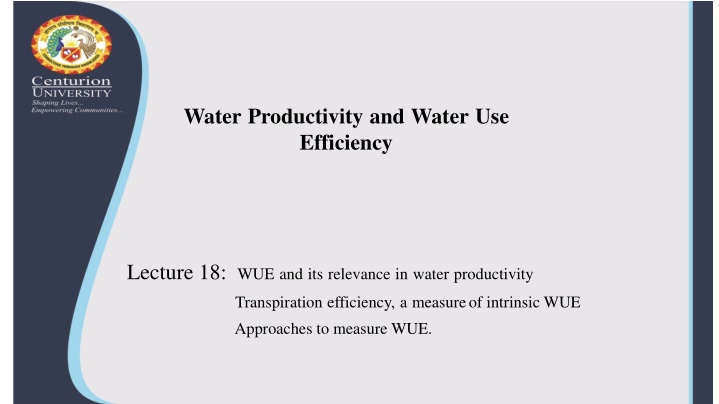
Water Use Efficiency and Its Impact on Crop Yield
Learn about water use efficiency (WUE) and its significance in maximizing crop productivity. Explore different measures of WUE, such as crop water use efficiency and field water use efficiency, and factors influencing WUE. Discover the concept of transpiration efficiency and strategies to improve water resource management for better agricultural outcomes.
Download Presentation

Please find below an Image/Link to download the presentation.
The content on the website is provided AS IS for your information and personal use only. It may not be sold, licensed, or shared on other websites without obtaining consent from the author. If you encounter any issues during the download, it is possible that the publisher has removed the file from their server.
You are allowed to download the files provided on this website for personal or commercial use, subject to the condition that they are used lawfully. All files are the property of their respective owners.
The content on the website is provided AS IS for your information and personal use only. It may not be sold, licensed, or shared on other websites without obtaining consent from the author.
E N D
Presentation Transcript
Water Productivity and Water Use Efficiency Lecture 18: WUE and its relevance in water productivity Transpiration efficiency, a measure of intrinsic WUE Approaches to measure WUE.
Introduction The term "water use efficiency" originates in the economic concept of productivity. Productivity measures the amount of any given resource that must be expended to produce one unit of any good or service. In a similar manner, water use efficiency measures the quantity of water taken up by the crop during its crop life to produce a unit quantity of the output i.e., crop yield. The lower the water resource input requirement per unit of crop yield produced, the higher the water use efficiency.
Crop water use efficiency: Crop water use efficiency is a ratio between marketable crop yield and water used by the crop in evapotranspiration. WUE (kg/ha.mm) = Y/ETc where, WUE = Water use efficiency in kg/ha.mm Y = Marketable crop yield in kg/ha ETc = Crop evapotranspiration in mm Field water use efficiency: Field water use efficiency is a ratio between marketable crop yield and field water supply which includes water used by the plant in metabolic activities, ET and deep percolation losses. FWUE = Y/WR where, FWUE = Field water use efficiency in kg/ha-mm Y = Crop yield in kg/ha WR = Water used in metabolic activities, ET and deep percolation losses in mm
OBJECTIVES Improving design for more efficient operation and management IMPROVEMENT OF: water resources management Better harmonization and regulation with irrigation system the service to irrigated agriculture Higher focus on capacity building to sustain WUE results the cost-effectiveness of infrastructure management More accurate measurement and recording of water services
Transpiration efficiency At a plant level, the transpiration efficiency (TE), an important component of WUE, is defined as TE = biomass/water transpired. At the leaf level, TE is defined as the intrinsic WUE; that is, the ratio of instantaneous CO2assimilation (A) to transpiration (T) = A/T. TE shows an inverse relationship with the VPD
The accurate gravimetric measurements of TE using a lysimetric approach The TE ratio is actually quite complex, as it depends on both genetic and environmental components [TE = kd/(e*a e)d], (where the term in parentheses reflects the vapour-pressure deficit (VPD) and kdis a coefficient that reflects the CO2concentration in the stomatal chamber) Passioura equation (Passioura, 1977) In which TE is one of the components (Yield = WU TE HI; where WU is the water used for transpiration and HI is the harvest index),












